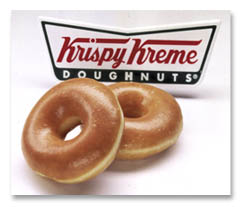The Rise and Fall of Yeast, Pt.1

A cautionary tale of ambition, greed, and inexperience.
I was sitting at Bobby Van’s with an iceberg wedge covered in bleu cheese, a Guiness and a blonde with legs like cellar spider. She looked like Heidi Klum so they sat us by the window. I rolled up my sleeves and unraveled yesterday’s Wall Street Journal. Page C6. It was June 2004.
What could’ve been more perfect than a Krispy Kreme doughnut? Hot from the fryer and loaded with sugar; their Original Glazed is like crack cocaine. And for a time, Krispy Kreme's stock seemed irresistible, too.
They went public in April 2000, and at the peak of the dot com hysteria, investors flocked to buy into a business they could understand; a business they could hold in their hands and swallow hole. And did often. I couldn't be a major shareholder and not gorge myself on the product, right?
An old-fashioned gooey sugary doughnut franchise from Winston-Salem, North Carolina, Krispy Kreme Doughnuts Inc. (KKD) boasted solid fundamentals, adding stores like an Australian bushfire; showing steadily increasing sales and earnings.
It got even better.
Krispy Kreme also had a mystique. Its doughnuts, available for many years only in the Southeast, had attracted a devoted, even fanatical, customer base. We called it the Krispy Kreme Cult. And so when they decided to go national, it opened franchises in locations guaranteed to generate buzz — Manhattan, Los Angeles, Las Vegas — and customers lined up around the block for a taste of that hot, gooey goodness. A warm, glazed doughnut, it was so simple.
They should’ve been selling it by the gram, smuggling it in from the Huallaga Valley. It was that good and that addictive. When those bales of cocaine washed up on the beaches of Cornwall, I could’ve sworn it was Krispy Kreme. I bet those surfers on Pentreath beach needed a fix.
Then on the morning of September 11, 2001 al-Qaeda waged war on the United States through a series of coordinated suicide attacks. Hijacking and then intentionally crashing two commercial airliners into the World Trade Center. When the market reopened a few days later, KKD shot like a cannon. People craved comfort and safety. They wrapped themselves in warm, friendly and familiar foods. Foods like warm, gooey, sugary, glazed doughnuts were like a safety blanket for a country confused and scared. Suddenly, in the face of such unending tragedy and fear, KKD looked even better. And it felt good to stand behind a company making people happy at a time like that. It was so simple.
By August 2003, KKD was trading at nearly $50, up 235% from its IPO price of $21 on Nasdaq.
Around that time Fortune called Krispy Kreme the "hottest brand in the land." For the fiscal year ended in February 2004, the company reported $665.6M in sales and $94.7M in operating profit from its nearly 400 locations, including stores in Australia, Canada, and South Korea.
Yeah, they didn’t stop expanding. Think Starbucks but with glazed doughnuts.
And then, it all came crashing. The wheels fell off. For as rapidly as its popularity spiked, KKD pitched into a steep downward spiral. A slow, violent, dramatic death, like watching a feather falling down an old well.
The company's woes officially surfaced in May 2004, when then-CEO Scott Livengood flat out blamed the low-carb Atkins craze for Krispy Kreme's first-ever missed quarter and first loss as a public company. That raised analysts' eyebrows, as blaming the Atkins diet for disappointing earnings carried a whiff of glazed desperation.
The SEC inevitably came knocking and in July 2004 they made an informal inquiry into Krispy Kreme's buybacks of several franchises. As the stock price plunged, shareholders filed suit. Franchisees alleged channel stuffing, claiming that some stores were getting twice their regular shipments in the final weeks of a quarter so that headquarters could make its numbers. Double the doughnuts, double the desperation.
The SEC upgraded its inquiry to "formal" status by October 2004. Average weekly sales, a key retailing measure, fell even as the company continued to add stores. In January 2005, Krispy Kreme decided to restate its financials for much of fiscal 2004. Scotty was replaced as CEO by turnaround specialist Stephen Cooper, who also kept his other job: interim CEO of Enron Corp.
The following month, the company announced that the United States Attorney's Office of the Southern District of New York was also joining the fray — a move indicating concern about possible criminal misconduct.
In April, Cooper shored up the doughnut hut by securing $225 million in new financing. The company announced that it expected a loss for its latest quarter, and warned investors not to rely on its published financials for fiscal 2001, 2002, and 2003, and the first three quarters of fiscal 2005, in addition to those for 2004. (As of yesterday KKD was trading at $3.24. The price of about 4 doughnuts.)
Krispy Kreme went underground. They shut down most of their stores and set up little kiosks in grocery & convenience stores, and gas stations. Krispy Kreme has been relegated to the shelves of Wal-Mart and Target. Loblaws and Petro-Canada gas stations and Tesco in the UK.
So what went wrong? How could a company in business for nearly 70 years, with an almost legendary product and a loyal customer base, fall from grace so quickly?
Stay tuned…


1 comment:
it occurred to me that I should sell my shares when off duty cops would drop of Krispy Kreme's off at the precinct kitchen when they parked at the airport and they would go uneaten. If a bunch of cops aren't chomping on doughnuts, then who will?
Post a Comment